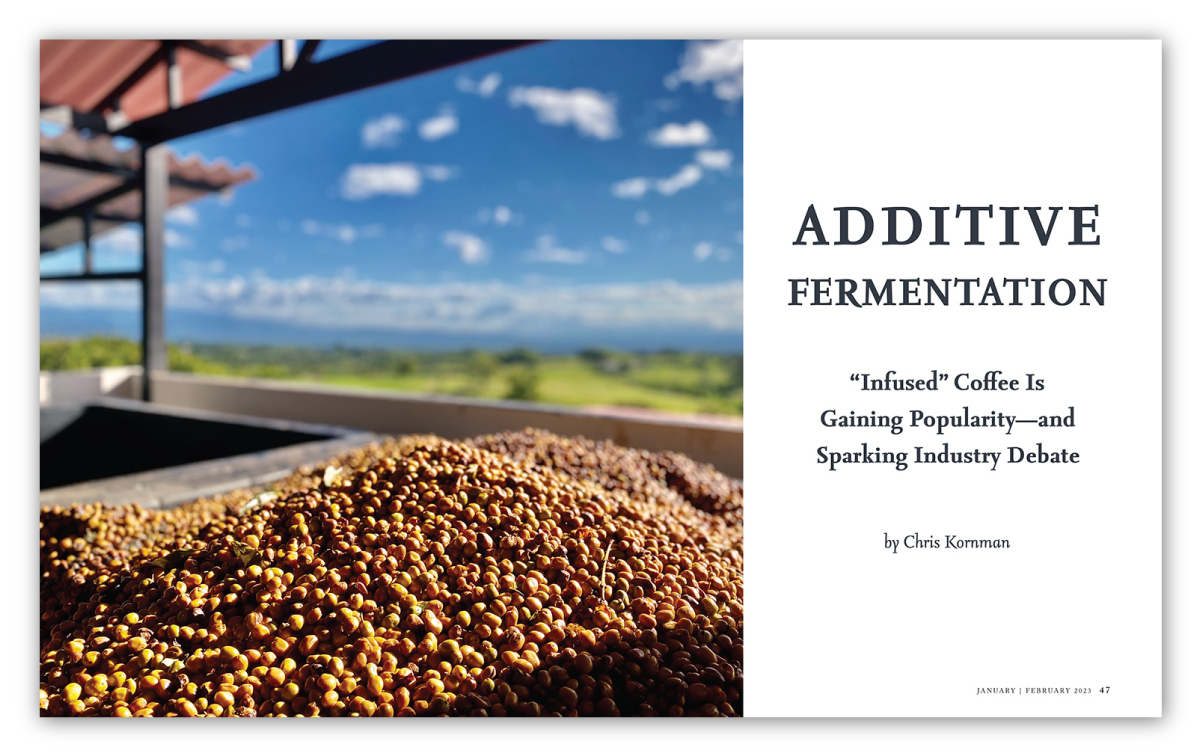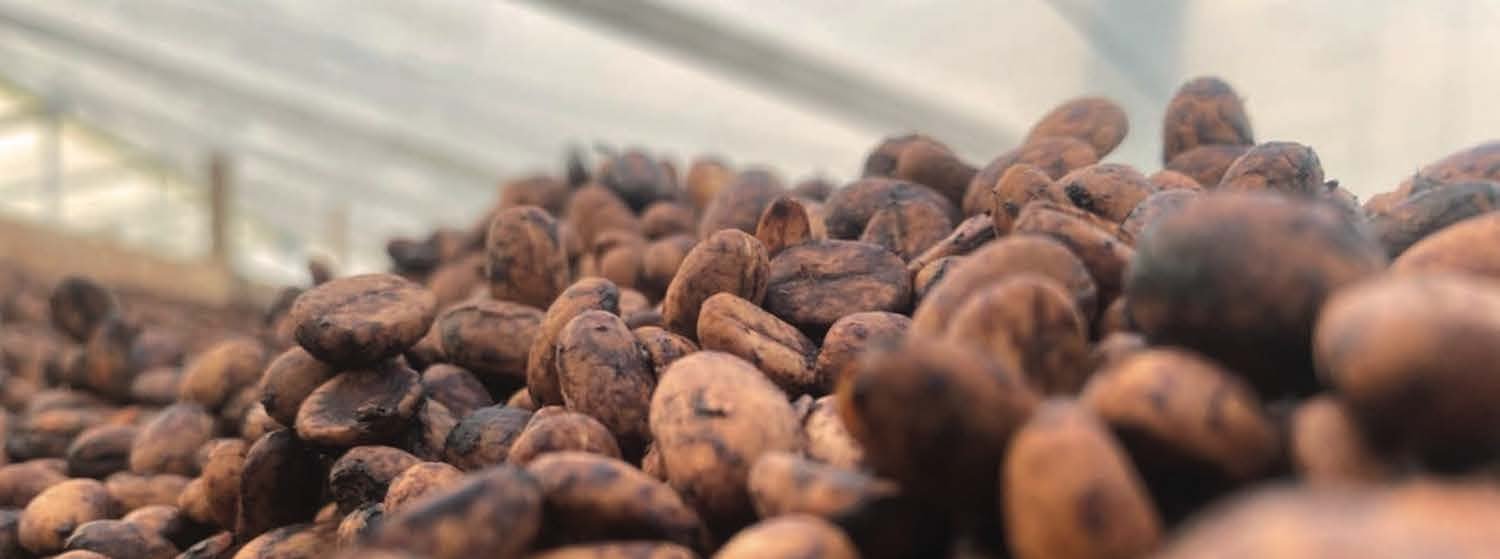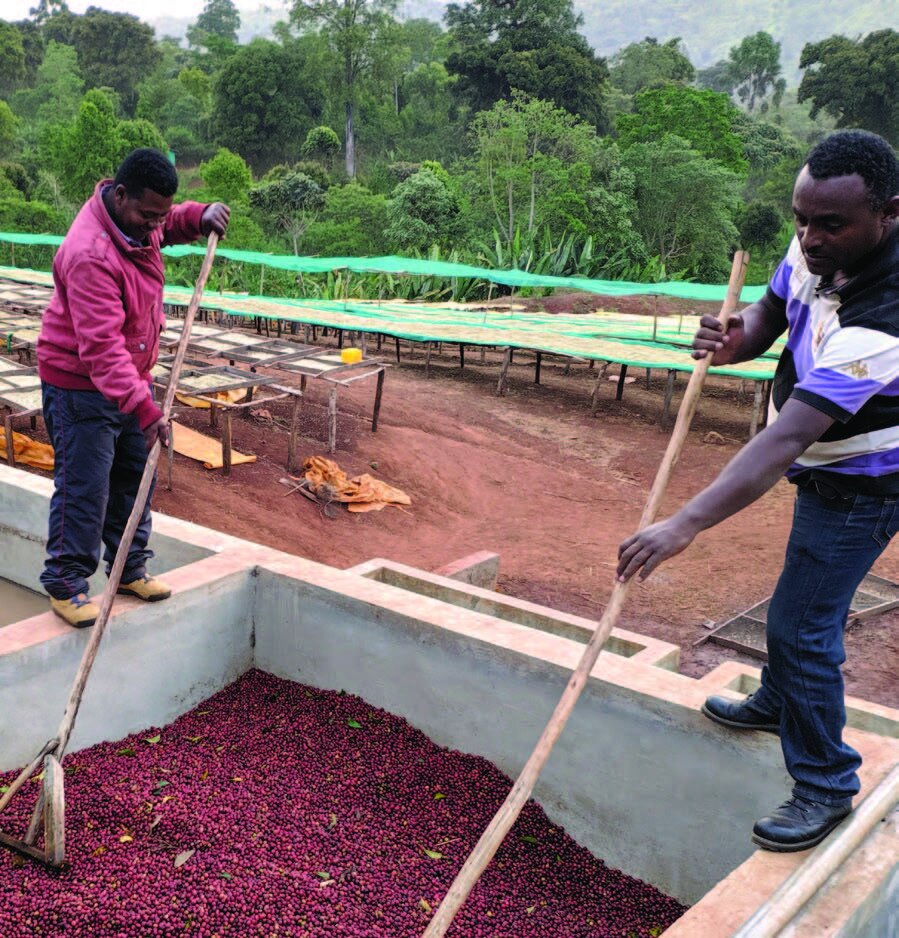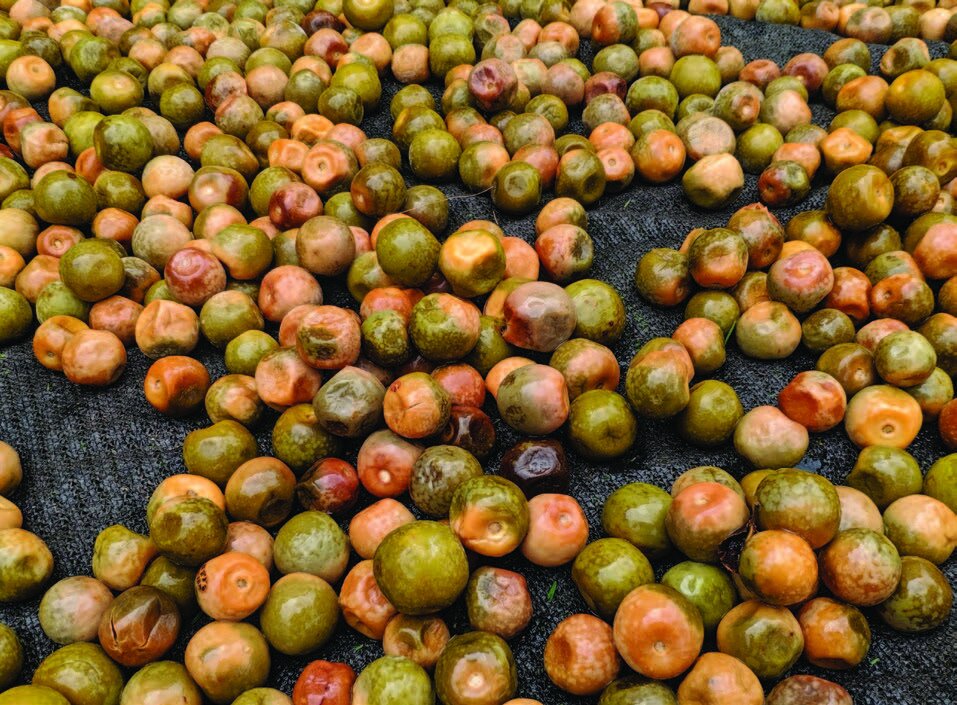Additive Fermentation: “Infused” Coffee is Gaining Popularity—and Sparking Industry Debate
By Chris Kornman
Upon receiving a gift bottle of co-fermented apples and grapes recently, I thoughtlessly posed the question, “Is it a cider or a wine?” My friend responded, “It’s both!” Perhaps a purist would respond differently, saying, “It’s neither!” Fluid definitions in beverage-making constantly challenge traditional understanding of our crafts.
In coffee, innovations in processing methods have become increasingly common. Successfully produced anaerobic and carbonic styles of fermentation regularly take top spots in cup quality competitions and top billings on roasters’ menus. Even honey processing is only a few decades old (“limited commercial volumes” were first available in 1993 per Robert Griffith, owner of Capricorn Coffee, an exporter in Brazil), and there was a time in distant history when washing and fermentation were experiments rather than the norm.
Yet nothing seems to irk traditionalists more than when you suggest infusing a coffee fermentation tank with anything other than depulped coffee cherries, water, yeasts and bacteria. Concerns about this type of fermentation “adulteration” range from potential allergen contamination to “cheating” in quality competitions.
Co-fermented honey-process parchment coffee. Photo by Edwin Noreña
Fermentation Additives
Fermentation for coffee has long been a simple matter of practicality—processors harnessed the power of bacteria and yeasts to extract the coffee seed from its fruit. It wasn’t viewed as a quality additive process; it was risk mitigation—reducing the amount of material separating us from the green bean, thereby reducing processing risk and improving consistency.
However, the past 10 years or so have proven to the specialty industry that fermentation also has potential to be additive. One trend among some coffee professionals is to take that “additive” principle as literally as possible by co-fermenting—or infusing—coffee pulp or whole coffee fruit with extra ingredients. (Let’s draw a quick distinction between “inoculation,” where a processor adds a starter culture—usually a known strain of yeast—to control the microbial population, and “co-fermentation,” where processors add food products to the slurry.)
The most common non-microbial substrate additive is fruit, but I’ve also seen hops, spices, organic acids and even pressed coffee pulp and juice—usually the runoff of a prior fermentation batch, sometimes called must or mossto in Spanish (in yet another example of wine language contorted into the coffee lexicon, as wine “must” is simply unfermented crushed grape juice and solids)—added to a coffee fermentation.
For roasters who sell their product to customers, there are understandable concerns about transparency in labeling and adherence to the U.S. Food and Drug Administration (FDA) guidelines. If something other than coffee is included in the bag of roasted beans, it would need to be labeled as such. However, for practical purposes when it comes to post-processing export, roasting and packaging, a co-fermented coffee is currently considered 100 percent green coffee—just like any other raw coffee product.
A traditional coffee fermentation tank. Photo by Marcelo Pereira
Allergens are another major consideration here, and one on which the jury appears to still be deliberating regarding co-fermented coffees. For ingredients of concern, best practice would likely dictate full clarity on inputs. However, industry and government standards are quite lax with regard to green coffee in general, which is seen as a low-risk product and generally exempt from most produce regulations other than the FDA’s “Good Manufacturing Practices,” which do not include language on listing co-fermented ingredients. Furthermore, because coffee undergoes a “kill step” by roasting and brewing, it is considered generally safe for consumption regardless of major flaws. To show the extent of this lack of regulation, existing language for green coffee from the FDA is unrestricted and considered fit for consumption even when including “adulteration” with live mold and/or insects at up to “10 percent by count of green coffee beans, or [better] than Grade 8 on the New York Green Coffee Association” standards, which allows an equivalency of 450 standard defects in a 350-gram sample.
Suffice it to say that guidance is lacking. Under current legal regulations, it does not appear that co-fermented coffees require any different handling or labeling than conventional beans. They are neither “fortified” nor “enriched” under current definitions, and it’s unlikely that any current regulatory body would recognize co-fermented coffee as anything other than green coffee. As a result, these experimental processes are not currently subject to any additional prerequisites.
Acidic Additions
Let’s examine a few reasons and methods producers might employ co-fermentation strategies.
One of my favorite coffee farms to visit is the Vohora family’s estate on the outer rim of the Ngorongoro caldera in Tanzania. While it’s been a few years since I’ve been back, Marcelo Pereira, a coffee processing consultant and quality specialist, recently visited the estate to spend time with Neel Vohora on the farm, and with Kavita Vohora at the quality control lab and dry mill in Arusha.
I spoke to Pereira, who has been encouraging producers like the Vohoras to infuse their anaerobic fermentations with citric acid or even citrus fruit. For Pereira, the decision starts at the cupping table.
“If you’re a good cupper, you don’t need a chemistry degree,” he claims. Pereira noted a distinctive lack of perceivable citric acidity in anaerobically fermented coffees and felt this style was missing something. “You can’t describe a coffee as perfectly clean without a little brightness,” he says.
Pereira began working with different acid types, including malic, tartaric and phosphoric, to increase the acidity. (It’s worth noting that these acidification techniques are well known and widely used in wine fermentation at both boutique and commercial scales.) Fermentation itself initiates a drop in pH, resulting in higher measurable acidity. In addition to altering the actual acidity, Pereira ultimately sought to improve the “perceived” sensory acidity.
Coffee cherries being prepared for depulping. Photo by Marcelo Pereira
Thus, adding enough citric acid (which he claims works best of all the trials he’s run) to lower the pH slightly—but not so much as to kill the yeasts and bacteria—alters the flavor profile. Pereira’s theory is that the no-oxygen fermentation environment encourages lactobacilli bacteria, which outcompete most of the yeasts we expect in more traditional, open-air coffee fermentation environments.
Lactobacilli metabolize sugars into lactic acid. Lactic acid is indeed sour, and lowers the pH of the substrate, but if you’ve ever prepped for the Coffee Quality Institute (CQI) Q Grader exam, you’ll know that lactic acid as we often experience it sensorially seems less sour than citric acid. “It’s more about mouthfeel than acidity,” Pereira says. He wants to present a more complete-tasting anaerobically fermented coffee to the public, using a fermentation additive. “From now on, I will always add citric acid for anaerobic,” he adds.
Coffee “Must” Ferment
Can you just throw anything into the tank and get coffee to taste like something different? Pereira speculates that without research and testing the average “infusion” experiment is unlikely to produce meaningful results, and that the investment (particularly in an additive that’s not readily available, such as non-native fruits) might not be worth the payoff. I can cite plenty of examples of co-fermentation gone awry for every success I’ve tasted.
Amanda Amato, coffee trader at Royal Coffee, buys a small amount of infused coffee from Edwin Noreña of Alquimista Specialty Coffee and Finca Campo Hermoso in Quindio, Colombia. Among Noreña’s more inventive coffees, his Black Ginger Ale Gesha is among the most complex and complicated, tasting quite a bit like fresh ginger, lime, hops and margarita mix.
The process is described by Noreña as “black honey double carbonic maceration mossto and galaxy hop” infused. The inclusion of hops in fermentation is unusual but not unheard of, despite the fact that hopping and fermenting in traditional beermaking are distinct processes.
The hops aren’t nearly as attractive to bacteria and yeasts as sugars and pectins in the coffee mucilage. But the roasted coffee does taste hoppy. (Noreña also does an aji-chili-infused ferment, which might be my love language). Does simply spending time together in a fermentation chamber impart new flavors? It’s probable.
Carbonically macerated whole coffee cherries drying. Photo by Marcelo Pereira
“Obviously, it does work,” Amato says, discussing flavor profiles, “otherwise they wouldn’t taste like ginger ale or hops.” While there are many iterations of failed or flawed attempts at such flavor-alteration, the success stories taste unique, and also distinctly like coffee, just with the volume turned up a little on the primary flavors, something quite different from a “flavored” coffee from a roasting facility.
Current understanding of traditional fermentation in coffee, per separate research presented at the 2021 ASIC Conference by both Valentina Lonzarich (Aromalab – Illycaffe spa) and Gerhard Bytof (Tchibo GmbH), is that microbial activity surrounds but doesn’t penetrate the seed itself, except in the case of the “ferment” sensory and “sour/stinker” physical defects. The flavors we assume are intrinsic in green coffee which we once talked about in terms of terroir and cultivar, however, have been shown to be dramatically, inalterably impacted by small changes in processing such as a few extra hours in controlled fermentation, a secondary post-ferment soak, or the amount of pulp left on the parchment. Our romantic idealization of the flavor of place and plant type are important, but largely subservient to process (as determined by Nestlé researchers Sophia Jiyuan Zhang, Florac de Bruyn, et al., at Vrije Universiteit Brussels in multiple studies published in Applied and Environmental Microbiology.)
Noreña’s audacious-sounding coffee could be taken as evidence of the producer’s (figurative) intoxication with fermentation’s power. However, for Noreña, his application of these processes is intended to be in service of the coffee’s inherent flavors, emerging out of respect. “It was a development that we adapted from the world of wine to enhance the flavors of coffee, always trying to intensify each coffee process using the original coffee flavors.”
Locally grown berries, shown here after co-fermenting with coffee cherries. Photo by Marcelo Pereira
This is evidenced by Noreña’s reliance on the coffee’s mossto as a primary additive. He’s literally just adding extra coffee juice and selected microbes from a previous fermentation batch of the same cultivar. “Mossto is a catalyst that helps to accelerate, control and enhance chemical reactions during coffee fermentation,” he explains.
Consider that the native yeasts and bacteria from a previous coffee batch will be naturally preselected as advantageous for the fermentation of coffee pulp, not to mention well-fed and energized. Rather than removing this biological fermentation engine and starting over from scratch for the next fresh batch of coffee, Noreña’s addition of “charged” mossto may improve the efficiency of fermentation for the new lot.
Applying the principle to a co-fermentation, if a microbe population is already suited to a non-coffee additive such as oranges, might we assume that the resulting flavors in such an environment are the result of the work of the increased diversity of biological infusion (yeasts and bacteria), in tandem with the additive (the fruit or other substance) itself? More studies must be done to better understand this distinction.
Roaster and Barista Community Reactions
For the purist, co-fermentation techniques represent a threat to traditional ideals of coffee flavor. The idea that a processor could “cheat” a coffee’s flavor profile by adding non-coffee product makes some uncomfortable, even though many coffee drinkers add substances like dairy, oat milk, sugar and flavorings to their beverages daily, to the very same end. However, potential opacity from a producer about their methods casts doubt in the mind of a terroir-driven roaster who seeks to highlight “inherent” flavors and transparency.
Further, it seems to brush awfully close against a specific regulation in barista championships, as outlined in the 2022 World Barista Championships (WBC) rules and regulations: “Coffee may not have any additives, flavorings, colorings, perfumes, aromatic substances, liquids, powders, etc. of any kind added at any point between the time the coffee is picked (as cherry) to when it is extracted into beverage. Substances utilized during growing, cultivation, and primary processing of the coffee are permitted (fertilizers, etc.).”
Co-fermented coffee parchment drying on a raised bed. Photo by Marcelo Pereira
The language is both confusingly restrictive and open ended. The first sentence indicates that no “additives … of any kind” may be used between harvest and brewing. This definition would exclude everything including water (a liquid), plus yeasts and bacteria, which are all requisite in fermentation. If we take the phrase allowing “substances utilized during … primary processing” at face value, then we have a gaping loophole which appears to leave the door open for additives in fermentation.
Even from within, our industry seems to lack clear guidance on the topic. While setting boundaries is the very nature of rulemaking in competitions, one might wonder about the relevance of restricting fermentation stylings for a contest like the WBC which largely judges the quality and skill of the barista’s work, rather than that of the processor.
Recently, Sasa Sestic, 2015’s WBC champion, publicly harangued infused coffees during the 2021 season, accusing competitors of failing the transparency test. An article authored by Sestic, positioning himself as a grandfather of “appropriate” flavor boosting (through carbonic maceration), calls for transparency and all but accuses roasters and processors of outright fraud (in the form of cinnamon-infused coffees) and offers suggestions of how to “test” for co-fermentations—a call to action that lacks scientific rigor and reads a lot like vigilantism to me.
In a rebuttal argument published on his personal blog, coffee industry consultant Christopher Feran notes a few problematic postulations in Sestic’s position. First, Feran ponders the troubling nature of casting coffee producers as “the villain in the narrative.” Secondly, Feran suggests that infused fermentation tanks are likely generating flavors due to “modulation of microbes controlling the fermentation”—the addition of a particular fruit may inoculate a coffee with unique yeasts or inhibit the presence of others.
Darrin Daniel, executive director of the Alliance for Coffee Excellence—which runs one of the industry’s best-known quality competitions and auctions, the Cup of Excellence (COE)—confirms that the COE has a no-tolerance policy for foreign ingredients such as fruits, spices or other non-microbial additives. “If it’s not part of the coffee chain, it’s not allowed,” he says. “We had farmers disqualified who were using, and stated that they weren’t using, these outside ingredients.” This exclusion does not extend to inoculation with a yeast culture or mossto infusion.
Barrels equipped for anaerobically fermenting coffee on Finca Campo Hermoso. Photo by Edwin Noreña
One of the earliest instances in the COE of an infusion accusation involved the Diamante parcel of Carlos Morera’s Finca El Cerro in Costa Rica. An annual entrant, it was the fourth-place finisher in 2017 that put “cinnamon coffee” on the radar for many. Using a mossto anaerobic fermentation technique, the coffee exhibits a strong spice aroma and flavor reminding some of gingerbread and cinnamon, and others of peppermint and menthol.
“That’s the one that set the whole thing in process for us,” Daniel explains. “The coffee tasted like mint or Altoids, but Diamante was steadfastly saying that they had not added anything. Then we tested that product, and in fact this looks to be a byproduct created as a result of fermentation and processing. That’s natural. They’ve continued to enter COE and have coffees that have that same profile … doing what they do with yeast and regular inoculation that’s created this flavor effect.”
For COE, the “purist” stance is accompanied by requisite transparency in processing from the producer. Institutionally, the competition’s goals of quality discovery, relationship-building and price ceiling exploration become less convincing if coffees are processed under a shroud of uncertainty.
The “Cinnamongate” controversy of competition starting in the late 2010s has spurred skepticism not just for those coffees destined for cuppers’ spoons and judges’ demitasse cups on the world stage, but even in fully transparent language used about coffees destined for the consumer market.
On a recent Instagram post, roaster and coffee person Kat Melheim celebrated a strawberry-infused Colombian coffee from Elkin Guzman she’d roasted for Black & White Coffee Roasters in Durham, North Carolina. The post garnered over 600 likes and nearly 70 comments, including a skeptical thread started by Yashar Afkary, the lead barista and coffee roaster from Number 10 Café in Muscat, Oman, and a competitor in brewer and barista championships. I reached out to Afkary, who told me he was concerned, if current trends continue, that “we’re going to forget about the taste of coffee.”
Coffee must (mossto) lab testing on Finca Campo Hermoso. Photo by Edwin Noreña
The worry that this year’s global volume of infused coffee (let’s generously estimate 10,000 bags, and roughly calculate that as representing 0.005 percent of the harvest if we propose 175 million bags as a reasonable approximation of all the coffee produced in a calendar year) could lead to planet-wide amnesia about coffee’s character seems a little far-fetched, but it’s also quite clear that Sestic and Afkary represent a wider contingent concerned about purity in coffee flavor.
Melheim agreed to an interview on the topic, and brought Black & White co-founder and coffee buyer (and former U.S. Barista Champion) Kyle Ramage to the conversation. After Melheim mentioned that these infused coffees tend to be unpredictable in the roaster, (perhaps due in part to inconsistent methods applied in the field to an assortment of products by different producers) requiring additional attention on the part of the operator “to find a roast degree, a roast level, that highlights the characteristics that have been imparted by the co-fermentation,” our conversation quickly turned to less concrete subject matter.
On the one hand, Melheim quickly noted that if you don’t like the idea of these coffees existing, you’ve got some pretty good options. “Don’t drink it. Don’t roast it. Don’t buy it. If you don’t want it, you don’t have to have it,” she says.
The absolute beauty and simplicity of this position is that it’s driven by what customers want. There’s an uncomplicated truth about consumer preference, not mired by esoteric nuance, that shows a clear choice. If there’s no market for co-fermented coffees, they will very quickly cease to exist. Black & White seems to think there’s demand—at the time of this writing, four out of its 20 single-origin offerings were processed using some form of co-fermentation or infusion.
On the other hand, Ramage ponders the very nature of specialty coffee, musing, “What do you want to celebrate in coffee? Is it the amazing characteristics of the cultivated and fermented seed? I think yes, because otherwise it becomes a slippery slope into a processing experiment rather than a growing and cultivating experiment. I love these coffees, and I want to celebrate how interesting they are, but I do not want them to represent what I view as pure excellence in the field of coffee cultivation and processing.”
Co-fermented honey process parchment coffee drying on Finca Campo Hermoso. Photo by Edwin Noreña
Transparency and the Way Forward
The clarion cry from those sensitive toward a potentially problematic type of processing is for a higher degree of transparency. We must know everything about the techniques to ensure purity of the product, goes the argument.
I was pleased to find that I’m not alone in experiencing some hesitancy to expose proprietary techniques that lead to great results for producers whose livelihoods may be dependent on a flavor note and cup score. Tim Heinze, Sucafina Specialty’s education manager, weighed in on Feran’s blog post with similar trepidation. Aside from health and safety concerns related to potential allergens, Heinze asks, “If a producer is able to hit the desired flavor note by adding something during processing, why do they have to disclose their competitive advantage?”
In the context of disclosure, there’s much that industry actors in consuming countries still obscure. Roasters rarely reveal blend components beyond country or macroregional designations, to the extent that, famously, a “Kona Blend” may be a little as 10 percent product from the Kona districts of the Big Island of Hawaii. Is it possible that our calls for transparency from producers are bordering on a double standard?
To answer that, a deeper question that’s worth considering and answering clearly is whether fermentation additives are considered “ingredients.” If so—the implication being that the finished green coffee product is partly something else (fruit or spice infused into the coffee)—clarity in labeling should be a requirement, particularly in the case of potential allergens. If not—which is to say, the green coffee’s flavor may be impacted but its nature as a raw product is not substantively altered, at least not more so than any other currently accepted method of post-harvest handling—then the “ingredient” list need only be published at the processor’s discretion.
Simply put, the essential question for co-fermented coffees, still waiting for an answer from either science or industry or some combination thereof, is whether we should be categorizing them as something distinct.
Coffee must (mossto) being added to a fermentation tank. Photo by Edwin Noreña
It could easily be argued that, unlike that bottle of co-fermented grapes and apples, a co-fermented coffee isn’t a multi-product blend. The final output is still just green coffee. The alternative is that we begin labeling with a far higher degree of stringency co-fermented coffees, from green to roasted and brewed states—informing a change in the name and identity of the final beverage.
The stakes here are high. In conversations with my colleague Josh Wismans, tasting room manager at The Crown, reservations about the vocal opposition to these types of coffees being included in the specialty coffee canon range from topic to topic wildly, from bogeymen and strawmen to Olympic medals. A phrase that really stuck with me was when he said, in reference to controlling centralized processing methods, “It’s almost like there’s a lot of money at stake.”
This is a central truth we can agree to, regardless of which side of the co-fermentation argument you fall on. My place in the supply chain makes me both a buyer and a seller, and consequently I spend a lot of time thinking about the outcomes of my decisions. In my role, I wield purchasing power and make final decisions based on a few cupping notes and a largely subjective scoring system, but I must also meet consumer demand. I choose to pay fairly for coffees, co-fermented or not, but must face the consequences of exterior forces such as inflation, oversupply, or simple lack of interest, which might threaten the economic sustainability of my cost per pound.
Accordingly, if you or I choose to buy and sell co-fermented coffees, implicit in that decision is to fulfill certain responsibilities to both our supply network and our customer base. This leads us ultimately back to the question of whether the differentiated categorization of co-fermented coffees is warranted, and to what types of labeling and transparency requirements may or may not be appropriate to best serve each actor in the coffee chain.
***
Chris Kornman is a seasoned coffee quality specialist, writer and researcher, and the director of education at The Crown: Royal Coffee Lab and Tasting Room in Oakland, California. He has extensive experience with coffee grading, roasting, sourcing, traveling and tinkering. He is the author of Green Coffee: A Guide for Roasters & Buyers.
Advertisement




















